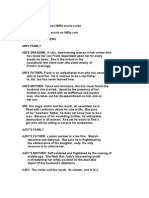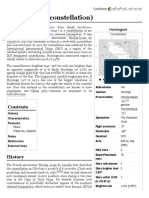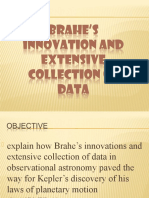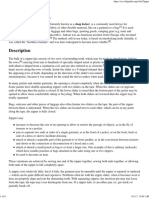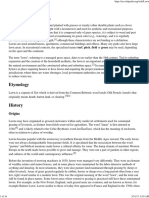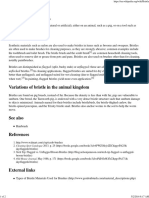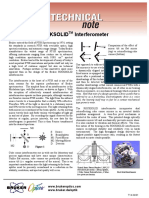Asteroid 449 Hamburga
Asteroid 449 Hamburga
Uploaded by
glh00Copyright:
Available Formats
Asteroid 449 Hamburga
Asteroid 449 Hamburga
Uploaded by
glh00Original Description:
Copyright
Available Formats
Share this document
Did you find this document useful?
Is this content inappropriate?
Copyright:
Available Formats
Asteroid 449 Hamburga
Asteroid 449 Hamburga
Uploaded by
glh00Copyright:
Available Formats
449 Hamburga - Wikipedia https://en.wikipedia.
org/wiki/449_Hamburga
449 Hamburga is a carbonaceous asteroid from the background
449 Hamburga
population of the intermediate asteroid belt, approximately 75
kilometers in diameter. It was discovered by German astronomers Discovery [1][2]
Max Wolf and Friedrich Schwassmann at Heidelberg Observatory Discovered by M. F. Wolf
on 31 October 1899, and later named after the city of Hamburg in A. Schwassmann
Germany.[3][2] Discovery site Heidelberg Obs.
Discovery date 31 October 1899
Designations
MPC designation (449) Hamburga
Hamburga is classified as a C-type asteroid and is probably Named after Hamburg [3]
composed of carbonaceous material. It is named for the city of (German city)
Hamburg in Germany.[3] The name was announced in 1901 during a Alternative 1899 EU · 1947 OA
festival held by the Mathematical Society of Hamburg.[3] designations 1948 TO · A901 EA
In the 1980s and 1990s, NASA considered a spacecraft mission to Minor planet main-belt · (middle) [4]
category background [5]
the asteroid.[18] The mission plan called for a launch in 1995 and a
flyby of Hamburga in early 1998.The McDonalds chain of Orbital characteristics [1]
restaurants expressed an interest in sponsoring the mission which Epoch 4 September 2017 (JD 2458000.5)
was discussed in exploratory meetings between themselves and
Uncertainty parameter 0
NASA. [19]
Observation arc 117.91 yr (43,066 days)
In August 1988 in the United States' city of Baltimore, P. Weissman Aphelion 2.9931 AU
addressed the International Astronomical Union on a mission to
Perihelion 2.1097 AU
this asteroid (449), a mission which also include a rendezvous with
Semi-major axis 2.5514 AU
Comet Kopf.[20] See Comet Rendezvous Asteroid Flyby for more on
the mission to the comet. This mission can also be compared to Eccentricity 0.1731
Rosetta, which successfully flew by two minor planets and orbited a Orbital period 4.08 yr (1,489 days)
Comet during its approach to the Sun in the early 21st century. P. Mean anomaly 228.86°
Weissman later worked on the Rosetta mission.[21]
Mean motion 0° 14m 30.48s / day
It was predicted that 449 occulted the star HIP 1424 in July Inclination 3.0847°
2013.[22] Longitude of 85.923°
ascending node
449 Hamburga was identified as one of three asteroids that were
Argument of 47.281°
likely to be a parent body for chondrites along with 304 Olga and
perihelion
335 Roberta.[23] All three asteroids were known to have low-albedo
Physical characteristics
(not reflect as much light) and be close to "meteorite producing
resonances".[23] Chrondrites are the most common type of meteor Dimensions 55.09 ± 14.25 km[6]
found on Earth, accounting for over 80% of all meteors.[24] They are 63.61 ± 0.75 km[7]
named for the tiny spherical silicate particles that are found inside 66.76 ± 4.82 km[8]
them (those particles are called chondrules).[24] 77.90 ± 22.29 km[9]
1 of 4 5/23/2018, 1:28 PM
You might also like
- Rebel Without A Cause (1955) Movie ScriptDocument128 pagesRebel Without A Cause (1955) Movie ScriptseamstobeNo ratings yet
- Total Eclipses of The Sun, ToddDocument272 pagesTotal Eclipses of The Sun, Toddandresmejia68100% (2)
- Secret Space Programs, Wars & "Cosmic Disclosure - Vol. 1Document520 pagesSecret Space Programs, Wars & "Cosmic Disclosure - Vol. 1FW04092% (38)
- Astronomy - The New CCD Astronomy PDFDocument486 pagesAstronomy - The New CCD Astronomy PDFknaexerNo ratings yet
- Observation HistoryDocument6 pagesObservation HistoryEzzie DoroNo ratings yet
- 1581 AbanderadaDocument4 pages1581 Abanderada6tdvjaz4eNo ratings yet
- 10 HygieaDocument2 pages10 Hygieakyle6zirik6belgeraNo ratings yet
- Ayló ChaxnimDocument8 pagesAyló Chaxnim6tdvjaz4eNo ratings yet
- AndromedaDocument30 pagesAndromedapem tigaNo ratings yet
- 55 Cancri eDocument8 pages55 Cancri enevelle4667No ratings yet
- Chapter 05 02Document64 pagesChapter 05 02ِDark DarknessNo ratings yet
- Andromeda GalaxyDocument12 pagesAndromeda GalaxyIulian PopaNo ratings yet
- 2 NeptuneDocument24 pages2 NeptuneFernando RamirezNo ratings yet
- Andromeda GalaxyDocument27 pagesAndromeda Galaxysebastian431No ratings yet
- Albion - WikipediaDocument3 pagesAlbion - Wikipediavidhiingle28079No ratings yet
- 10.1007@978 3 642 54718 825Document33 pages10.1007@978 3 642 54718 825William BautistaNo ratings yet
- SednaDocument11 pagesSednaGoran SNo ratings yet
- Jules Verne - All Around The MoonDocument122 pagesJules Verne - All Around The Moonmahya ebNo ratings yet
- Historical Observations: Ancient and Medieval ObservationsDocument2 pagesHistorical Observations: Ancient and Medieval ObservationsEzzie DoroNo ratings yet
- Endeavour (OV-105)Document2 pagesEndeavour (OV-105)Bob AndrepontNo ratings yet
- PlutoDocument24 pagesPlutoChristine ToledoNo ratings yet
- Gamma Ray BurstDocument18 pagesGamma Ray Burstbosonvoyagernishith1915No ratings yet
- In The Sky: Mars ManeuverDocument1 pageIn The Sky: Mars ManeuverRatneshNo ratings yet
- Crab NebulaDocument20 pagesCrab NebulaAbraxazNo ratings yet
- Beyond The Visible I: Radio Astronomy: Early Work: Jansky and ReberDocument7 pagesBeyond The Visible I: Radio Astronomy: Early Work: Jansky and ReberPratik DabhadeNo ratings yet
- Oumuamua: Oumuamua Is The First KnownDocument41 pagesOumuamua: Oumuamua Is The First KnownSevn feedNo ratings yet
- Around the MoonFrom EverandAround the MoonEleanor E. KingNo ratings yet
- 25267Document143 pages25267kaczmarechNo ratings yet
- Schiehallion Experiment: Background Finding The MountainDocument8 pagesSchiehallion Experiment: Background Finding The MountainAdrian IosifNo ratings yet
- QuasarDocument12 pagesQuasarAMAN VERMANo ratings yet
- Comet Shoemaker-Levy 9Document13 pagesComet Shoemaker-Levy 9haindavuduNo ratings yet
- Exoplanets 3Document5 pagesExoplanets 3anwarNo ratings yet
- Horologium (Constellation)Document8 pagesHorologium (Constellation)joanna thompsonNo ratings yet
- Wolfschmidt Island Universe or Big Galaxy PRAG Mysterium Cosmographicum 1996Document14 pagesWolfschmidt Island Universe or Big Galaxy PRAG Mysterium Cosmographicum 1996kaponjaNo ratings yet
- 2017 APR. 13 - The MINOR PLANET CIRCULARS/MINOR PLANETS AND COMETS - M.P.C. 103973Document12 pages2017 APR. 13 - The MINOR PLANET CIRCULARS/MINOR PLANETS AND COMETS - M.P.C. 103973Reinaldo Martinez-VelazquezNo ratings yet
- Pluto: This Article Is About The Dwarf Planet. For Other Uses, SeeDocument7 pagesPluto: This Article Is About The Dwarf Planet. For Other Uses, SeeLak DavisNo ratings yet
- The Discovery of Quasars: Abstract. Although The Extragalactic Nature of Quasars Was Discussed As Early As 1960, ItDocument18 pagesThe Discovery of Quasars: Abstract. Although The Extragalactic Nature of Quasars Was Discussed As Early As 1960, ItACHINTYANo ratings yet
- Uranus - WikipediaDocument32 pagesUranus - WikipediaBryan Paul BautistaNo ratings yet
- 3192 A'HearnDocument3 pages3192 A'Hearn6tdvjaz4eNo ratings yet
- Burnham's Celestial Handbook, Volume Three: An Observer's Guide to the Universe Beyond the Solar SystemFrom EverandBurnham's Celestial Handbook, Volume Three: An Observer's Guide to the Universe Beyond the Solar SystemRating: 4 out of 5 stars4/5 (1)
- Timeline of Knowledge About Galaxies, Clusters of Galaxies, and Large-Scale StructureDocument8 pagesTimeline of Knowledge About Galaxies, Clusters of Galaxies, and Large-Scale Structuresebastian431No ratings yet
- Chapter 1 - Universe 0 Solar System Lyst1489Document16 pagesChapter 1 - Universe 0 Solar System Lyst1489tupakulaNo ratings yet
- Barnard's StarDocument14 pagesBarnard's Starsteffany3442No ratings yet
- NeptunesesDocument13 pagesNeptunesesRüstəm Emrah QədirovNo ratings yet
- Milky WaysDocument47 pagesMilky Wayshendro ajahNo ratings yet
- Gamma-Ray BurstDocument33 pagesGamma-Ray Burstemanala2015No ratings yet
- Mars - WikipediaDocument25 pagesMars - WikipediaKabir KhanNo ratings yet
- Morphology and Characteristics of Radio PulsarsDocument37 pagesMorphology and Characteristics of Radio PulsarsViren MandaoganeNo ratings yet
- Nanno Marinatos The Cosmic Journey of OdysseusDocument36 pagesNanno Marinatos The Cosmic Journey of OdysseusFabio AppolinarioNo ratings yet
- 789 Lena - WikipediaDocument4 pages789 Lena - WikipediaMohammed AbdelnasserNo ratings yet
- 210D4: Paleomagnetism D4.1 Introduction To Paleomagnetism: Geophysics 210 November 2008Document10 pages210D4: Paleomagnetism D4.1 Introduction To Paleomagnetism: Geophysics 210 November 2008Elvis OnovugheNo ratings yet
- 5D BrorsenDocument2 pages5D Brorsenerikjarvinen0No ratings yet
- Chandra X-Ray Observatory - WikipediaDocument3 pagesChandra X-Ray Observatory - WikipediabztNo ratings yet
- PulsarDocument20 pagesPulsarjustin.gregory.bieverNo ratings yet
- Space: Sputnik 1 Satellite Yuri GagarinDocument9 pagesSpace: Sputnik 1 Satellite Yuri Gagarinedwin chooNo ratings yet
- Brahe's InnovationsDocument54 pagesBrahe's InnovationsRamona Esteves100% (9)
- Jan 1st, 1000 ARISTOTLE - (384-322 BC) Jan 3rd, 1000 PTOLEMY - (AD 140)Document3 pagesJan 1st, 1000 ARISTOTLE - (384-322 BC) Jan 3rd, 1000 PTOLEMY - (AD 140)Margie Ballesteros ManzanoNo ratings yet
- Caragan Vincent M MWF: 9:30-10-30Document7 pagesCaragan Vincent M MWF: 9:30-10-30Marisa CaraganNo ratings yet
- GalaDocument23 pagesGalaRohithNo ratings yet
- Pluto - WikipediaDocument34 pagesPluto - WikipediaBryan Paul BautistaNo ratings yet
- Transport Phenomena SummaryDocument6 pagesTransport Phenomena Summaryglh00No ratings yet
- Little Bit of Morse Code History From WikipDocument2 pagesLittle Bit of Morse Code History From Wikipglh00No ratings yet
- Forensic Science - WikiDocument1 pageForensic Science - Wikiglh00No ratings yet
- Hydrogen Wiki IntroDocument1 pageHydrogen Wiki Introglh00No ratings yet
- Tiny House Movement WikiDocument1 pageTiny House Movement Wikiglh00No ratings yet
- Misc IbilityDocument1 pageMisc Ibilityglh00No ratings yet
- From Wikipedia, The Free EncyclopediaDocument1 pageFrom Wikipedia, The Free Encyclopediaglh00No ratings yet
- Wiki SnailDocument1 pageWiki Snailglh00No ratings yet
- From Wikipedia, The Free Encyclopedia: DictionaryDocument1 pageFrom Wikipedia, The Free Encyclopedia: Dictionaryglh00No ratings yet
- Etymology: Bears Are Mammals of The Family Ursidae. Bears Are Classified As Caniforms, or Doglike Carnivorans, With TheDocument1 pageEtymology: Bears Are Mammals of The Family Ursidae. Bears Are Classified As Caniforms, or Doglike Carnivorans, With Theglh00No ratings yet
- Wiki SnailDocument1 pageWiki Snailglh00No ratings yet
- TulipsDocument1 pageTulipsglh00No ratings yet
- Origins: From Wikipedia, The Free EncyclopediaDocument1 pageOrigins: From Wikipedia, The Free Encyclopediaglh00No ratings yet
- BristlesDocument1 pageBristlesglh00No ratings yet
- Lawson Peak: ReferencesDocument1 pageLawson Peak: Referencesglh00No ratings yet
- ParrotsDocument1 pageParrotsglh00No ratings yet
- PlasticsDocument1 pagePlasticsglh00No ratings yet
- The Fermi ParadoxDocument20 pagesThe Fermi Paradoxbullshit0976587No ratings yet
- Basic Astrology - Mod 1 - Chap 1Document9 pagesBasic Astrology - Mod 1 - Chap 1badriaa_1No ratings yet
- Earth Moon Sun RelationshipDocument12 pagesEarth Moon Sun RelationshipMichelle Raquil100% (1)
- SF4 - 2023 - 1893844 - Gaboc Elementary SchoolDocument2 pagesSF4 - 2023 - 1893844 - Gaboc Elementary SchoolConie M. ClaudianNo ratings yet
- GOLDEN DAWN Highlights of The Second Knowledge LectureDocument11 pagesGOLDEN DAWN Highlights of The Second Knowledge LectureF_RC75% (4)
- Astro.cafeastrology.com-Natal Chart ReportDocument24 pagesAstro.cafeastrology.com-Natal Chart ReportmailpuhorNo ratings yet
- Herschel ProjectDocument14 pagesHerschel Projectapi-285213466No ratings yet
- Relational FinTop FinGlTop FinGlShrdSetupCmn - FinGlProgramMiscDocument1 pageRelational FinTop FinGlTop FinGlShrdSetupCmn - FinGlProgramMiscKhalil De la CruzNo ratings yet
- Science Lesson AstromyDocument3 pagesScience Lesson Astromythe.efroNo ratings yet
- Life Cycle of StarsDocument5 pagesLife Cycle of Starsk42hrvbqgbNo ratings yet
- Ajp jp4199101C114Document10 pagesAjp jp4199101C114rosctNo ratings yet
- Ryholt - New Light On The Legendary King Nechepsos of EgyptDocument14 pagesRyholt - New Light On The Legendary King Nechepsos of EgyptPiero Pizziconi100% (1)
- Moda MexicanaDocument75 pagesModa MexicanaLeslie AguilaNo ratings yet
- J. E. Lagnese, Günter Leugering, E. J. P. G. Schmidt Auth. Modeling, Analysis and Control of Dynamic Elastic Multi-Link StructuresDocument397 pagesJ. E. Lagnese, Günter Leugering, E. J. P. G. Schmidt Auth. Modeling, Analysis and Control of Dynamic Elastic Multi-Link Structuresfernando hervert perezNo ratings yet
- Rock SolidDocument1 pageRock Solidkarthikdhadala0% (1)
- Electrical Engineering - Remote SensingDocument43 pagesElectrical Engineering - Remote SensingAnaStairsNo ratings yet
- Lesson 1 Principles of RadiationDocument21 pagesLesson 1 Principles of RadiationKorina_Gomez_2744No ratings yet
- Air Geography Notes For UPSCDocument2 pagesAir Geography Notes For UPSCsonuhd1995No ratings yet
- Biology NEET - Embibe PDFDocument8 pagesBiology NEET - Embibe PDFrohith0% (1)
- The Orbit of The Moon Around The Sun Is Convex! PDFDocument3 pagesThe Orbit of The Moon Around The Sun Is Convex! PDFbondmumbaiNo ratings yet
- CCST 9051 - 2021 - Lecture 5-SJXDocument25 pagesCCST 9051 - 2021 - Lecture 5-SJXhkuengg2021No ratings yet
- Dane Rudhyar - The Planets and Their SymbolsDocument13 pagesDane Rudhyar - The Planets and Their Symbolsbosiok100% (2)
- Golden Age ProphecyDocument4 pagesGolden Age Prophecygdm1andonly100% (2)
- Employee Motivational Meeting by SlidesgoDocument40 pagesEmployee Motivational Meeting by SlidesgoPerfect VideomakerNo ratings yet
- Lab Activity Chapter 1Document3 pagesLab Activity Chapter 1Ahsan AliNo ratings yet
- Different Types of Optical InstrumentsDocument9 pagesDifferent Types of Optical InstrumentsCarlos Othello BaloloyNo ratings yet
